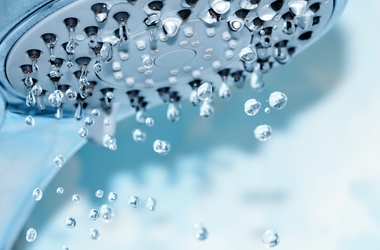How to Keep Shower Screens Free From Limescale
Concisely summed up in the dictionary, limescale is ‘A hard white substance consisting chiefly of calcium carbonate, deposited by water on the inside of pipes, kettles, etc.’ As calcium carbonate naturally occurs in solids such as chalk, limestone and mollusk shells you can see how it can create a big problem when deposited in pipes and around surfaces.
We all know it is a common issue everywhere but where does it come from and can it be avoided? Well, the simple answer is this; hard water causes limescale and without intervention, or depending on your postcode, it is pretty much unavoidable. Even if you are lucky to be located within a soft water area you will still notice a build up over time.
Why does limescale build up so quickly on shower screens?
When hard water is heated or left to evaporate on a surface, such as a shower screen, any dissolved minerals which were in the water, solidify leaving behind white, chalky lime scale. This becomes a recurring problem for people who clean shower screens and then rinse off using water from the shower head and leave to air dry.
Showers are used everyday and keeping them clear from limescale and grime is of the utmost importance especially in an industry like the hotel or leisure sector. It sounds foolish to say but a majority of people using public or shared facilities want to live under the illusion they are the first ones to use it. Limescale build up on the glass really does highlight the questionable cleanliness of the shower itself and can lead to complaints or negative reviews. Depending where the shower is located, simple maintenance like using a squeegee after each use can go a long way to prevent heavy build up.
How to remove limescale from shower screens
When it comes to shower screens there is good news. Removing limescale from a large, flat surface is pretty easy and can be done quite quickly with little effort depending on the solution you use. However the most important thing to remember is most off the shelf limescale removers come with a huge list of DON’TS and very few DO’s. Limescale (calcium carbonate) is quickly and easily dissolved by acid – the problem is, so are most other things such as sealants, plastics, stone, and human skin. Many ‘go-to’ brands of limescale remover are very harsh and can cause irreparable damage if not used carefully. They are also highly toxic and can cause severe burns if contact is made with human skin. If you find these too risky or would rather use a safer product there are alternatives on the market that work just as well, if not better than acid limescale removers.
Other alternative methods also include using vinegar or citrus fruits which are also reasonably effective but can work out expensive or requiring multiple applications in the long run. Additionally, the sharp, harsh scent of vinegar isn’t particularly appealing when you get into a shower for the first time and isn't the most effective way cleaning a shower.
Contact time is key
The main issue many people speak about when removing limescale is getting the contact time right. Any solution needs time to react with the calcium to break it down. Unfortunately you can’t just wipe a cloth over it, and it is this mistake many make. If you spray the solution and immediately wipe it off it may look like it has done the trick (as the liquid has absorbed into the limescale it will give it that ‘transparent’ appearance) however, you’ll find that within hours the limescale will be back. The longer the contact time the better. However, this also becomes problematic when using strong acid based cleaners as inevitably the longer you leave it the more likely it is to start eating in to other surfaces like sealants and ceramic, so always opt for a less harsh alternative.
How to keep shower screens free from limescale
Firstly, depending on the solution you’re using you’ll need suitable protective clothing and gloves.
- Gather your items. You’ll need limescale remover, glass cleaner, a sponge (with both a soft and coarse side), microfiber cloth and glass cloth.
- Spray down the shower screen with your limescale remover. Once the surface area is covered massage in using the coarse side of your sponge. Remember contact time is key so leave to work for several minutes. NOTE: Some limescale removers are incredibly strong and can cause irreversible damage to surfaces so always follow the instructions on the back of the bottle.
- When you’re ready to remove the limescale remover don’t rinse with the shower head as this will leave you with a disappointing finish. Instead, dilute down a bottle of glass cleaner and use with a microfiber cloth. As you wipe over the screen you’ll notice the limescale just lifts away.
- When you’ve wiped clean the area finally finish off by buffing with your window cloth.
- Once complete you’ll be left with a shower screen that looks like it has just been installed. Keep it looking this way by building this process into your weekly maintenance plan and keep a squeegee to hand where showers are located for daily maintenance.

